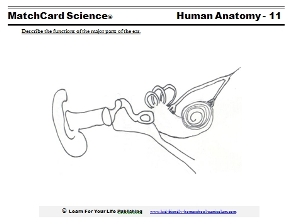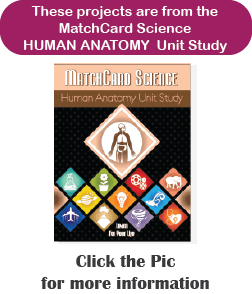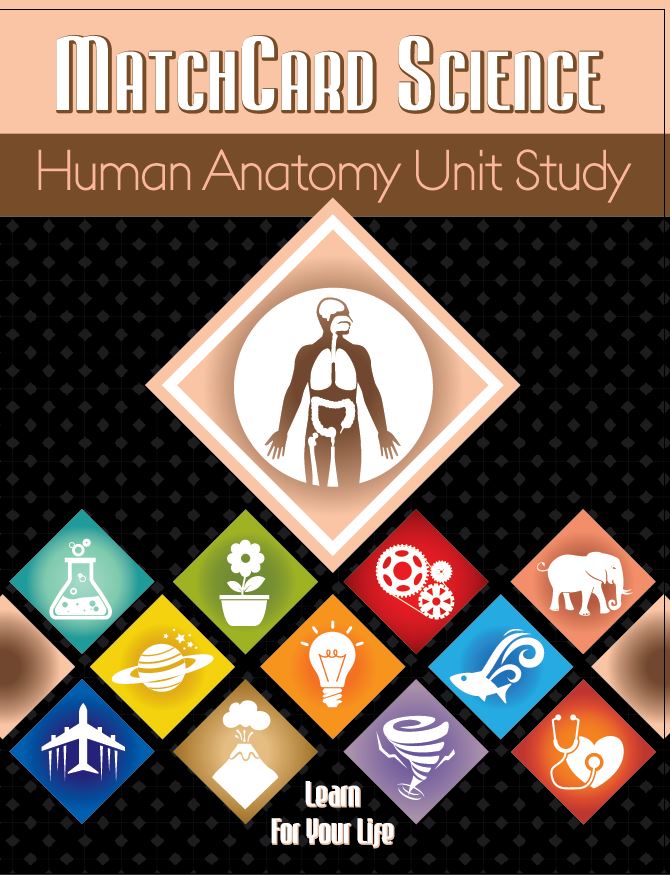Human Ear Diagram
Anatomy of the Ear Worksheet
This human ear diagram is from the MatchCard Science Human Anatomy Unit Study..
Free Download Below


Download Ear Anatomy Diagram and Information Pieces
> Objective: Describe the functions of the major parts of the ear.MatchCard: Download below.
MatchCard Information Pieces describe the functions of the major parts of the ear anatomy. Students match the information pieces to the human ear diagram.
Download and Use the Human Ear MatchCard
Here is MatchCard #11 of the Human Anatomy Unit Study. See below for more information on using MatchCard Science.Lesson Plan Activities For The Human Ear
The a-"mazing" ear
With a pencil in their dominant hand, ask students to feel their own ear with their non-dominant hand and draw the shape of their ear with the other. This is a quick and interesting way to start the human ear lesson.Make an ear drum
Use a piece of plastic wrap and stretch it over a cup. Secure it firmly with a thick rubber band. Drop pieces of rice on it, and watch the rice bounce as the "drum" is lightly tapped with a pencil eraser.Of course, you can use more expensive materials to make an actual drum or use a drum which would demonstrate it better.
Notice the difference in sound caused by tapping the pencil on the drum, compared to another surface.
Compare the vibrations on the rice if you tap a hard surface compared to the drum top.
Introduce the ear drum - also called the tympanic membrane. What makes it vibrate? (Answer: sound waves). Show the tympanic membrane on the human ear diagram.
Three Little Bones
The tiniest bones in your body are in your ear. Vibrations from the ear drum hit the little bones, make them vibrate, and send the message to the auditory nerve. (That's the official name for the ear nerve, or the hearing nerve.)These little bones are fun to learn about, even if you can't see them. The first is the Hammer (officially known as the malleus. You can describe a mallet.) Look on the human ear diagram. It looks a little like a mallet.
The hammer hits the Anvil, which is official known as an incus. It doesn't look much like an anvil, but it is hit by the hammer bone.
The last little bone is the Stirrup, or stapes in Latin. Can you see why it is called that. Check out some pictures of horse saddles with stirrups if you can't.
Bone Conduction - Another Way to Hear
One lesson on the human ear should be spent learning about the ear drum, the hammer, anvil, and stirrups, and the stimulation of the auditory nerve.In a separate lesson, let's learn about another way the brain gets messages about sound: Bone Conduction.
The best way to study this is with a tuning fork. If you don't happen to have one, we'll give you a simple and free alternative below.
If you do have a tuning fork, hit it to start it vibrating. Then put it against the skull over the forehead. You can also hear it by placing the end of the tuning fork on the skull behind the ear.
Hearing tests are conducted by comparing how long a person can ear the vibrations through their forehead, compared to both ears. Conduction loss can be noted in one ear with this test. That kind of hearing loss often happens in adulthood, but kids have fun doing the tests.
Here's a way you can demonstrate conduction without a tuning fork. Place one finger on your forehead. Tap that finger with your other index finger. Bring your finger half an inch from your head and repeat. There is a big difference in the sound.
Try a similar experiment behind your ear. (Move long hair out of the way.) Place the index finger on the bone behind the ear, then tap the index finger with the middle finger of the same hand. Do it again with your finger moved half an inch away from your skin and note the difference.
Can you think of any time people use bone conduction to ear? What about the practice of trackers putting their ear on the ground. That is using bone conduction.
You might want to try it for fun.
Check the diagram
Look at the human ear diagram carefully and notice the different paths that sound conduction and bone conduction take to get to the brain. See the cochlea? It changes the signals from bone conduction into electrical impulses that are conducted by the auditory nerve.Dizzy
The semi-circular canals contain tiny hairs that help with balance.Kids often like getting dizzy. (I'm not sure why. I liked it as a kid, but now think of it as a form of torture.) If your kids are game, go ahead and spin them around and let them enjoy being dizzy for a while. Ask them to walk in a straight line.
What happened? Those tiny little hairs were swirling so fast in the semi-circular canals they caused the person to become dizzy.
The semi-circular canals also function in another capacity. When the person is still, they help determine which way is up. This could be helpful for someone who is buried in snow after being caught in an avalance. I do NOT recommend that as a learning activity, however.
Build Your Own Ear Model
Make a model
This was a favorite activity for my kids. We lined up kitchen chairs to make a tunnel, which was the ear canal. The tunnel was the human ear. They had to create the other parts of the ear anatomy as stations.Draw Your Own Ear Anatomy
Look at different pictures of the human ear. They can then create their own drawing using different colors.Build a Model
You can always build your own ear model out of clay (or kitchen chairs as described above.)Some less creative people might prefer to buy a model to build. There are a number you can purchase from Amazon as well as other internet and local suppliers.
MatchCard Science
How To Use MatchCards

Download the FREE MatchCard Science Instructor's Guide and see how MatchCards can make building their science knowledge base fun.
Human Anatomy Unit Study

Download the entire Human Anatomy Unit Study
12 Science Unit Studies

Chemistry is only one of twelve complete unit studies for kids in 3rd to 8th grade.
Comprehensive objectives, hands-on projects, suggested science fair experiments, and the fun game-like MatchCards keep them interested in learning science. See all twelve MatchCard Science Unit Studies.
About Our Site
Hands-On Learning














